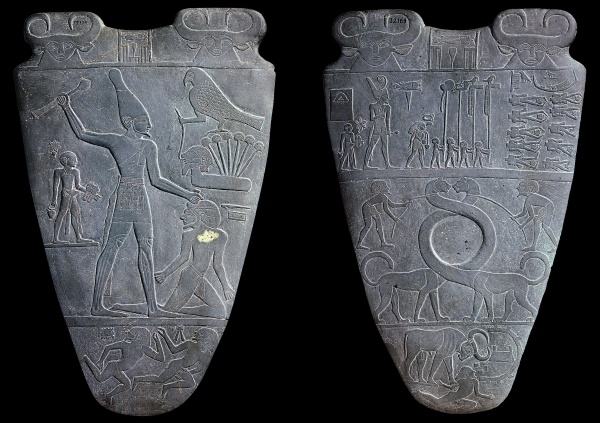Facts About Narmer Palette
The Narmer Palette, also known as the Great Hierakonpolis Palette or the Palette of Narmer, stands as a distinguished artifact of ancient Egyptian history. Dating back to approximately the 31st century BC, this item is among the earliest examples of hieroglyphic inscriptions, believed to represent the unification of Upper and Lower Egypt under King Narmer. It is a rich repository of early Egyptian art and symbolism.
Unearthed between 1897 and 1898 by British archaeologists James E. Quibell and Frederick W. Green at the Temple of Horus in Nekhen (modern-day Hierakonpolis), the Narmer Palette is now housed in the Egyptian Museum in Cairo. The palette, shaped like a shield and sculpted from a single piece of siltstone, features intricate raised relief carvings on both sides, depicting King Narmer in a series of symbolic scenes. Notably, the scenes portray Narmer donning both the White Crown of Upper Egypt and the Red Crown of Lower Egypt, symbolizing his dominion over a unified Egypt.
The Narmer Palette forms part of a collection of artifacts discovered in the Main Deposit at Nekhen, which includes the Scorpion Macehead and the Narmer Maceheads. Together, these objects provide some of the earliest visual depictions of an Egyptian king, rendering them indispensable to our comprehension of early Egyptian history.
Scholars have long debated the true meaning of the Narmer Palette. Some contend that it documents actual historical events, specifically the unification of Egypt under Narmer. Others argue it serves a more symbolic or mythological role, potentially illustrating events from the year it was dedicated to the temple.
Beyond its historical importance, the Narmer Palette has permeated popular culture, appearing in films, novels, and video games. Regardless of its precise function, the Narmer Palette remains a seminal piece of ancient Egyptian history. Its early iconography and symbolism offer a fascinating glimpse into the cultural and political dynamics of the time.

 Israel
Israel